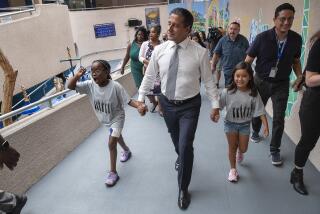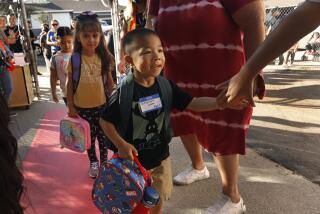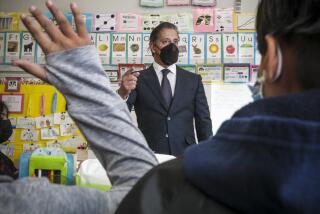Help the students COVID-19 has pushed through the cracks

- Share via
With California having recorded more than 2 million coronavirus cases and the holidays giving us no reason to think people have been cautious and staying isolated, most California public-school students are still learning at home and will be for weeks to come. The Los Angeles Unified School District has announced that when classes resume in mid-January, they will be conducted remotely.
That makes sense right now, but it’s also reason to be more and more worried about the stalled academic, social and emotional growth of students, not to mention the impact on the families who have acted as tutors, counselors and endlessly inventive social directors to keep kids on track, and the parents and guardians struggling just to get by. Some older siblings have neglected their own schoolwork because they were needed to babysit or oversee the lessons of younger brothers and sisters.
The chasm between rich and poor has been widening at a worrisome rate. One new study shows that low-income students are making considerably lower progress with math than they were a year ago, while high-income students are actually progressing at a faster rate than before the pandemic. More affluent students have parents who can afford learning pods and other tutoring help that speeds up the pace of learning. And though no one can blame parents for doing their best by their kids, the yawning inequity is unacceptable.
For that matter, white, middle-class and affluent students are far more likely to be able to attend regular school at least part time, according to a report out of Columbia University. That’s been obvious just from looking at the experience in the Los Angeles area.
There are various ideas about how to help students catch up once they’re back in a regular classroom — up to and including having many of them repeat a year. But right now, facing the probability of many more weeks online, it’s time to think about how to rev up online school for hundreds of thousands of disengaged students in California.
Los Angeles Unified recently took a significant step toward this by reaching an agreement with United Teachers Los Angeles that adds a half-hour of instruction per week during the second semester, and, more important, a half-hour a day of office time to confer with parents and students. It’s not a world-beating advance; the district’s previous agreement with teachers shorted students on time with teachers, offering them far less than many other large school districts in the state. It’s not enough, but the private sessions will do more for students than extra time in Zoom lessons, where many of them quickly wear out or grow bored.
Many L.A. Unified teachers already provided the extra time and more. But doing the right thing by students has to be required, not voluntary. As rough a time as this is for school districts and parents, schools in Los Angeles and across the state must go all-out in an attempt to retrieve students who are giving up learning. That needs to include real attendance requirements; L.A. Unified defines student attendance so broadly that kids can spend a minimal amount of time in sessions and still be defined as attending.
Earlier this month, state Supt. of Public Instruction Tony Thurmond outlined several steps toward improving educational outcomes this school year. They include coming up with strategies to help the most disadvantaged students, encouraging the use of CARES Act money to help the neediest students, and conferring with civic groups that have made educational equity their mission.
Thurmond needs to move very fast if he wants to make a difference next semester. Strategizing and conferring with groups should have been in the works months ago; students can’t afford further delay. “Encouraging” school districts isn’t enough; Thurmond needs to use his bully pulpit to harangue districts to pull out all the stops as soon as the second semester begins, both to give teachers the guidance they need, and to put more tutoring, counseling, family outreach, physical exercise and creative activities into the daily lives of students.
The new pandemic relief bill will provide major help — four times as much as the CARES Act did for K-12 schools. State leaders, including legislators, should be figuring out the requirements for using that money to help the most vulnerable kids. At the same time, they need plan for a return to campuses as soon as feasible.
It’s a tough task and an unforeseen one, but that’s the job these officials signed up to accomplish.
More to Read
A cure for the common opinion
Get thought-provoking perspectives with our weekly newsletter.
You may occasionally receive promotional content from the Los Angeles Times.









